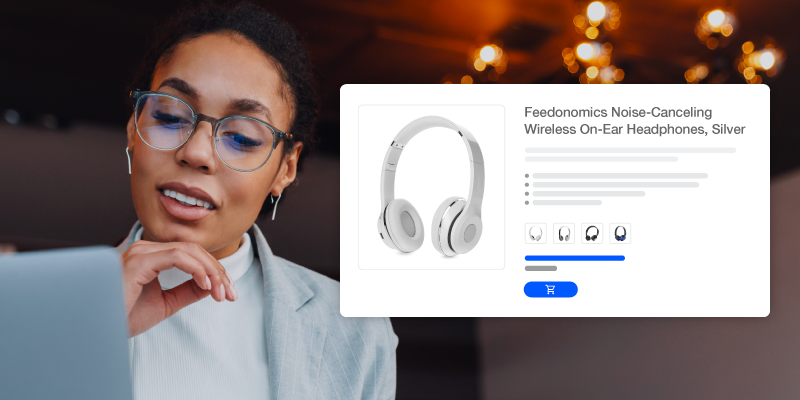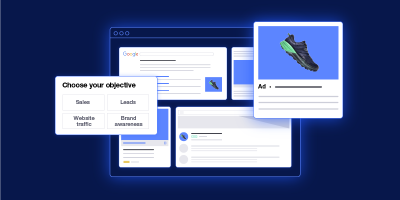There’s a reason so many retailers and brands choose to advertise their products on Google Shopping. Not only does Google capture more than 90% of the global search market with around 5.6 billion searches a day, it is also the leader in digital ad spend, totaling around $134 billion in 2019, according to Statista.
Optimizing your product listings on Google Shopping is incredibly important and can be the difference between a conversion and a forgotten product. Product titles in particular have a big impact on the performance of shopping ads. When product titles aren’t optimized, merchants miss countless opportunities to reach shoppers and drive more conversions.
However, optimizing product titles is much easier said than done. If you have a massive product feed, it can be daunting to update and optimize each listing in line with Google’s requirements and best practices. Plus, titles on Google Shopping are tricky—there’s no one-size-fits-all formula.
While title requirements for Google are the same across product categories, best practices for Google Shopping product title optimization tend to vary greatly for different categories. This means that one title structure might work perfectly for apparel but won’t yield the same results for electronics, for example.
Below we’ve laid out some best practices for Google Shopping titles, as well as some examples for all the major product categories on Google.
What Are Google’s Requirements and Best Practices for Product Titles on Google Shopping?
To start optimizing your product titles, first ensure they meet Google’s requirements. There are a few core requirements all titles must meet, regardless of product category:
Product titles that follow Google’s requirements:
- Are shorter than 150 characters
- Include relevant language that describes the product
- Distinguish between variants
- Use professional and grammatically correct language
- Should not feature foreign or gimmicky characters
- Should not use capital letters for emphasis
- Should not include promotional text like sales price, delivery date, sale dates, etc.
Google uses the words in your titles to match search queries with the most relevant products, so it’s important to include details such as brand name, age group, gender, size, and color for the best results. Optimized titles can lead to more impressions, higher conversion rates, and improved return on ad spend (ROAS). While meeting Google’s requirements is essential for getting product ads approved, merchants should also follow Google’s recommendations for maximum optimization.
These best practices include:
- Using all 150 characters
- Putting the most important details first since Google sometimes truncates product titles in ads
- Incorporating keywords like product name, and specific details—such as “maternity”—for apparel
Find out how Feedonomics’ feed solution can help automate, categorize, and optimize your product listings for Google Shopping.
What Are Feedonomics’ Best Practices for Google Shopping Titles?
Google requirements and best practices provide helpful guidance for product titles, but once they have been met, there is still quite a bit of room for different stylistic choices, such as punctuation and title casing. That’s where Feedonomics comes in. Our feed specialists research the title nuances for each channel and work closely with merchants to optimize their titles for increased search-relevancy, taking into account key features of their products, individual style preferences, and the search terms they know customers use to find their products.
Ben Kelsey, an onboarding supervisor at Feedonomics, recommends these best practices for Google Shopping:
Front-load titles with information that is important to that specific product.
Like Google recommends, putting the most important information at the front of your title is a good practice, but that can vary from merchant to merchant and, potentially, product to product. Some common elements to consider include recognizable brands and features that distinguish the product, like color, size, etc.
As a best practice, if an important attribute isn’t visible in the image, it’s best to include that detail near the beginning of the title. Attributes like color are more likely to be shown in the product image, but details like “waterproof” are hard to see, so you want to mention that near the beginning of the title.
Make your titles read like a sentence.
When writing product titles, you want to make them easy to read and flow naturally. Our feed specialists recommend ordering elements logically and adding helpful words or characters to create clear breakdowns between elements. Having titles that read naturally helps customers understand the information they are being presented and makes the titles more appealing.
Include product nouns.
While some products have technical names or descriptions that merchants use to refer to that product, they aren’t always terms that a customer would use, either because they don’t know them or their search isn’t that specific yet. You want your titles to have the right information to target both those customers who know exactly what they are looking for and those customers who are still in the research phase of their shopping journey. A/B testing can help you decide which product nouns might yield the best results.
“The ideal title will capture both general and more specific searches, have a natural flow, and include the most relevant elements at the beginning so the customer can see important features without needing to expand the title.”
Below, we have listed some examples of optimized product titles in the main categories of Google Shopping:
Examples of Google Shopping Titles by Category
Animals & Pet Supplies
Product type: dog supplies
Recommended additional info: ingredients, breed, age, weight
Example: Feedonomics All-Natural Chicken & Rice Adult Dog Food, 25 lb Bag
Apparel & Accessories
Product type: clothing
Recommended additional info: size, color, gender, fit, or design
Example: Feedonomics Women’s Stretch-Fit Ankle Pants, Black, Size 12
Arts & Entertainment
Product type: arts & crafts kits
Recommended additional info: features, design, skill-level
Example: Feedonomics Needlepoint Kit for Beginners, Vase of Flowers
Baby & Toddler
Product type: baby toys & activity equipment
Recommended additional info: features, age group, number of pieces
Example: Feedonomics Toddler Alphabet Puzzle, Ages 2+, 27 Pieces
Business & Industrial
Product type: retail
Recommended additional info: quantity, character limit, accessories
Example: Feedonomics FeedoPrice Gun With 5000 Sticker Label, 8 Characters
Cameras & Optics
Product type: photography
Recommended additional info: quality, features, model, size, accessories
Example: Feedonomics 3-Flash Reflector, Foldable, Silver/White, 8.5” x 5.5”
Electronics
Product type: audio players & recorders
Recommended additional info: special features, material, speed, color
Example: Feedonomics 3-Speed Portable Bluetooth Record Player With Built-In Speakers, Blue
Food, Beverages & Tobacco
Product type: cereal & granola bars
Recommended additional info: ingredients, amount, flavor
Example: Feedonomics Blueberry Oat Organic Breakfast Blend, 6-Pack
Furniture
Product type: outdoor furniture
Recommended additional info: weight, quantity, material, accessories
Example: Feedonomics 6-Piece Solid Wood Patio Furniture Set With Dining Table, Outdoor Umbrella, and 4 Chairs
Hardware
Product type: chain, wire, & rope
Recommended additional info: quantity, length
Example: Feedonomics 13” Bungee Cords, Extra Strength, Set of 2
Health & Beauty
Product type: bath & body
Recommended additional info: scent, ingredients, size
Example: Feedonomics All-Natural 12 fl oz. Liquid Hand Soap, Lavender & Rosemary
Home & Garden
Product type: birdhouses
Recommended additional info: material, size, color
Example: Feedonomics Solid Wood Deluxe Bird Cottage, 10.5” x 11.5”, White
Luggage & Bags
Product type: backpacks
Recommended additional info: gender, color, special features like waterproof, frameless, etc.
Example: Feedonomics Women’s Adjustable Waterproof Hiking Backpack, Green
Mature
Product type: erotic clothing
Recommended additional info: size, color, features, material
Example: Feedonomics Lace Lingerie Set with Matching Bra And Underwear, Red, Size M
Media
Product type: print books
Recommended additional info: subtitle
Example: Feed On: A Practical Guide to Succeeding in Ecommerce
Office Supplies
Product type: desk organizers
Recommended additional info: special features, material, size, adjustable
Example: Feedonomics Large Natural Bamboo Desktop Organizer With Extendable Storage Drawers, Slate Grey
Religious & Ceremonial
Product type: wedding ceremony supplies
Recommended additional info: material, style, color
Example: Feedonomics Rustic Flower Girl Basket, Small, Ivory
Software
Product type: web design software
Recommended additional info: the word “subscription”, subscription duration, software year, series
Example: Feedonomics 2020 Professional Web Design Series 10, 1-Year Subscription
Sporting Goods
Product type: exercise & fitness
Recommended additional info: material, color, features
Example: Feedonomics Extra Thick Non-Slip Yoga Mat, Mint
Toys & Games
Product type: stuffed animals
Recommended additional info: style, size, material
Example: Feedonomics Plush Stuffed Frog, Small, 9 Inches
Vehicles & Parts
Product type: recreational vehicles
Recommended additional info: transmission system, color, features
Example: Feedonomics Quad Utility ATV, Four Wheel Drive, Black and Red
Conclusion
Optimizing your product titles is an important first step in improving the search-relevancy of your products on Google Shopping. Since you can’t bid on keywords in Shopping campaigns, it’s important your products have details that Google can easily match with users’ searches. Feedonomics’ full-service solution for advertising optimizes your product data automatically to improve visibility, conversion rates, and ROAS.

With its leading data feed management platform, Feedonomics helps brands, retailers, and agencies optimize and list products on hundreds of shopping destinations around the world. Learn more about our full-service solutions for advertising channels and marketplaces.




